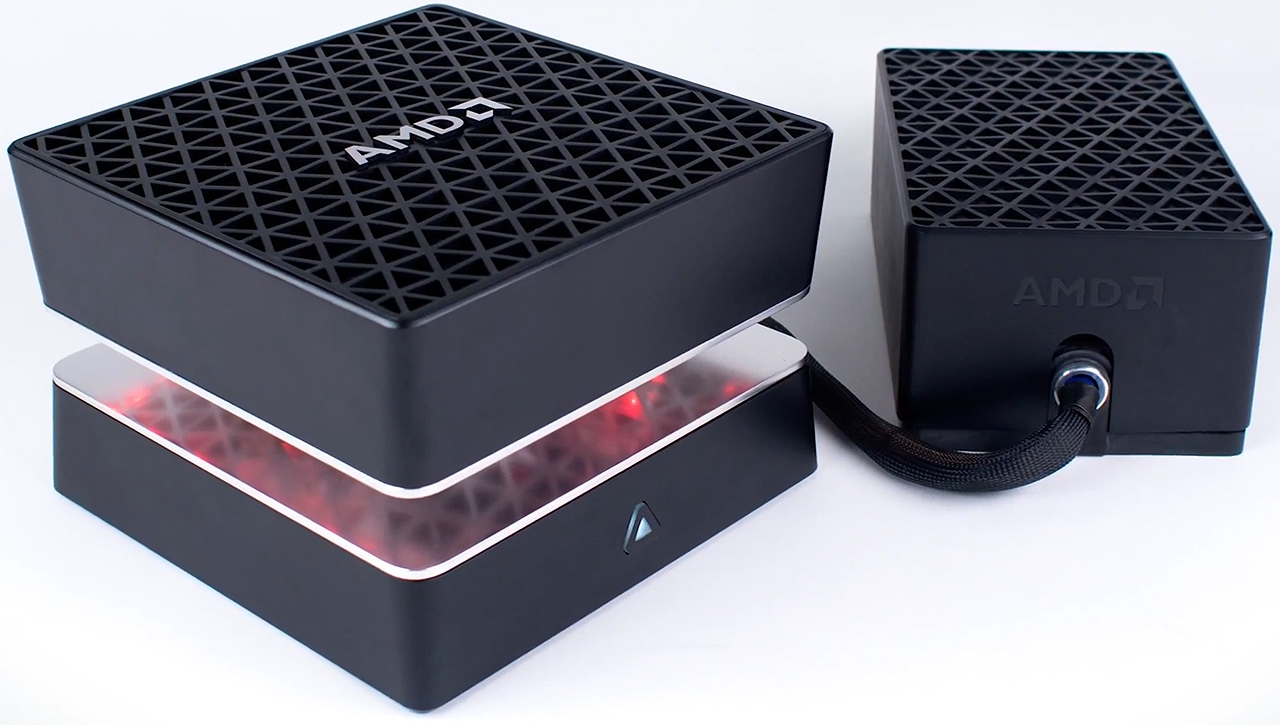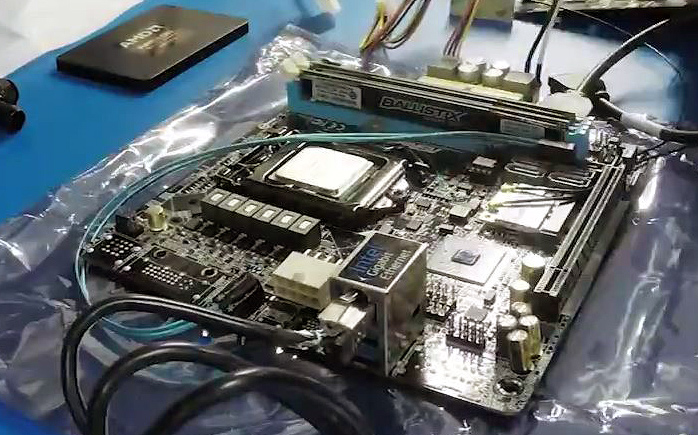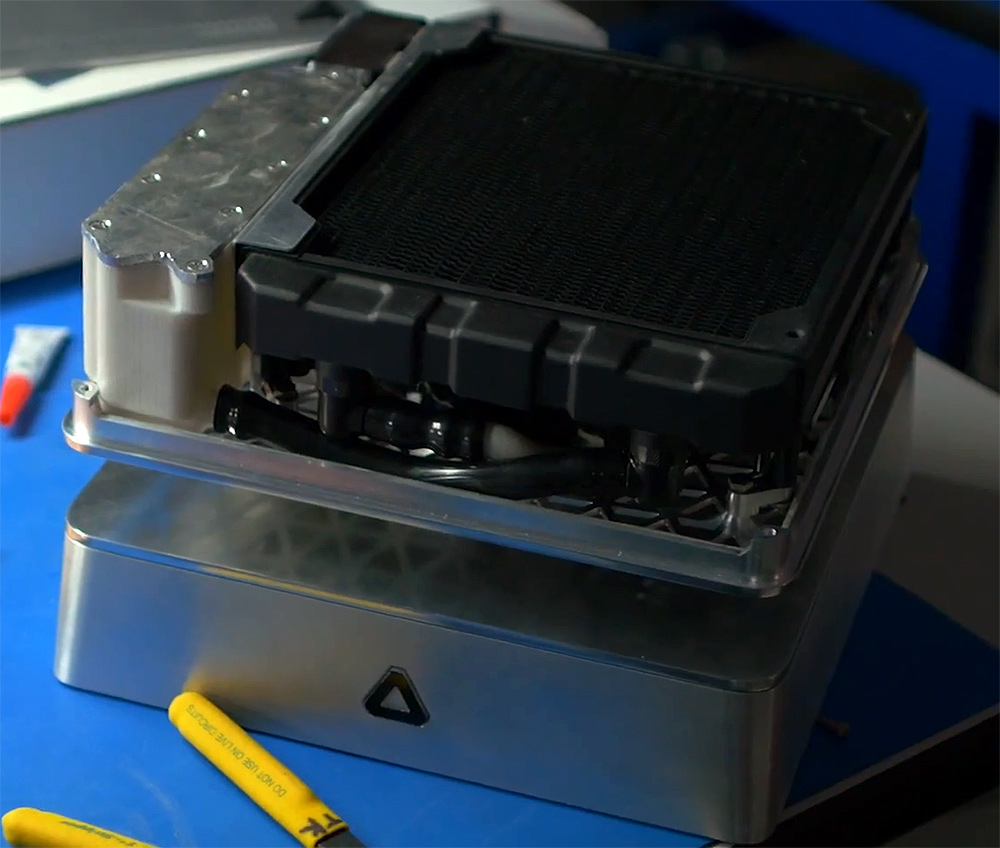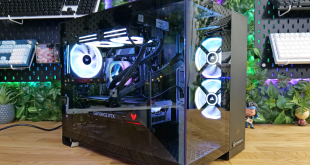Advanced Micro Devices’ project Quantum small form-factor system concept is nothing but impressive. It promises to deliver leading-edge performance in all games in ultra-high-definition resolutions thanks to two AMD Radeon R9 Fury graphics processing units. Apparently, in order to provide truly uncompromised performance, AMD had to use Intel Corp.’s central processing unit inside its ultra-small PC.
Leading-edge gaming PCs with several GPUs are usually either rather bulky or noisy. AMD’s project Quantum small form-factor system concept is designed to show end-users and PC makers that it is possible to build high-end SFF gaming PCs that are both small and silent. The Quantum uses dual-chamber system topology, where one chamber contains all processing hardware, whereas another contains a sophisticated cooling system. While AMD’s project Quantum is a custom-built PC, it uses a lot of off-the-shelf components too.
“The uniqueness of Quantum is the fact that it actually has split design, where the bottom side does all the water-cooling of the components and the upside does the cooling of the water itself,” said Ali Merrikh, thermal architect at AMD Innovation Lab.
Based on AMD’s own demonstration, the project Quantum is based on a customized version of Asrock’s Z97E-ITX/ac mainboard as well as an Intel Core i7-4790K “Devil’s Canyon” processor, which is currently the highest-performing mainstream CPU from AMD’s arch-rival. The SFF PC also uses AMD’s upcoming Radeon Fury X2 dual-GPU graphics card with unprecedented computing power, which is stacked beneath the motherboard.
The inner design of the “processing chamber” uses a lot of custom hardware, such as waterblocks, risers, lighting and other. Obviously, the dual-chamber PC case itself is also custom-built by a leading maker of PC enclosures.
With two AMD Radeon R9 Fury “Fiji” graphics processing units operating in CrossFireX mode with 8GB of HBM memory in total, one can expect AMD’s Quantum to deliver 60 to 90 frames per second in all games when played in 4K (3840*2160) resolution, something that not a lot of gaming PCs can provide. Thanks to the fact that DirectX 12 will provide a number innovative multi-GPU modes, the dual-GPU graphics card with 8GB of HBM memory will be able to demonstrate great efficiency, at least in certain games.
The project Quantum was designed by AMD Innovation Lab to demonstrate what can be done, but AMD expects select partners to offer such systems to end-users later this year. Actual pricing of Quantum PCs is completely unclear, but such systems will not be affordable. AMD’s project Quantum PCs will ship with Microsoft Windows 10 and DirectX 12, expect them to be available this fall or during the holiday season. Given the availability timeframes, it is possible that AMD’s partners will decide to use Intel Core i7-6700K “Skylake” processors along inside.
Discuss on our Facebook page, HERE.
KitGuru Says: AMD’s project Quantum system look rather exotic, remarkable and its concept of liquid cooling seems like a good solution for enthusiasts. However, there is a computer with serious performance and rather extreme thermal design power, but which looks even more stylish and which is probably easier to build. It is called Apple Mac Pro (it features a multi-core Intel Xeon CPU with 95W TDP as well as two AMD FirePro graphics cards with “Tahiti XT” GPUs that have serious power draw too) and it has been available for well over a year now. Perhaps, makers of gaming PCs could adopt a similar concept? Of course, custom components are expensive and the Mac Pro is virtually unupgradeable. Nevertheless, it looks very well and is probably a tad more reliable since it lacks liquid cooling.
 KitGuru KitGuru.net – Tech News | Hardware News | Hardware Reviews | IOS | Mobile | Gaming | Graphics Cards
KitGuru KitGuru.net – Tech News | Hardware News | Hardware Reviews | IOS | Mobile | Gaming | Graphics Cards







Oh! the Irony
lol
Zen in future 😉
The comment about the mac pro has no place. Tahiti xt vs 2 x fury x ? I don’t think people realize the performance being spoken of. Its something like 2 titan x in that tiny thing, except faster.
It’s an ITX board and there are non AM3+ based ITX board, Asus claims to have had one on the drawing board but said there simply wasn’t a demand for it, but even if there was, since most games shown off today will still be based on DirectX 11 the Intel CPU is a logical choice, I hope Zen changes that.
Well said. One can simply not compare a Firepro d300 and d500 based on older chips and traditionally not optimized for games, to the new R9 Fury. The Fury is next level of even the highest tier of gaming GPU’s, yet crammed into this small form factor AND there are two of them. Two. Crazy.
AMD should start selling their own laptop as well.
For the very least for a standard reference like 2-3 models only with no stupid 720p in >10″, min ram 4GB, etc.
I don’t think anybody would mind as the scarce options for AMD. Heck, even MS is selling their own tablet and Intel is selling their own NUC board.
please people dont try to talk about Apple Macs as gaming machines… theyre not… and seriously this AMD concept brings ridiculous specification to the table… it looks like a solid idea… good luck to AMD and i hope this hits mainstream soon…
Buys Radeon Fury X2 for 4K gaming – finds out it only has HDMI 1.4a
Buys Quantum PC — a 4K gaming machine by AMD – finds out it has Intel CPU inside.
AMD got rekt today beyond any damage control with just two news alone…
That, and the FX chips are tùrds that get pushed around by an i3 in many games. I actually expected them to use a 5820K.
No HDMI 2.0 is a massive massive oversight by AMD. Such a shame 🙁
This can support FX.
This can support FX.
Are you certain? Looks like it potentially could for sure but Zotac only states support for up to Thuban based Phenom(6 core). The other problem here is the board only has a small PCIE 2.0? x1 slot.
you are wrong, the entirety of FX line uses AM3+ socket while that mobo is an AM3
it supports Phenom II, Athlon II, Sempron
The J0bSite on the Net @mk2
….
http://www.FinanceNetMoneyleep/tap/tab….
Hey author so where’s the source that it says “INTEL CPU” is really used? I only see the ethernet port with Intel on it. Is this really confirmed? Did AMD told you?
Even if amd uses Intel CPU here, the major point they are trying to showcase is their GPU performance. The could have used a high end carrizo for all they care.
I’m getting confuse with this article. Mac Pro? lol; it’s not a gaming hardware….. sigh…….
who cares about HDMI.. lawl.. Display port is the way to go!
People think that AMD CPU & GPU divisions are so connected.. it’s still 2 different companies basically that share a name … and what’s wrong if they use Intel CPUs? .. They are superior to what AMD CPU division has to offer.
Look at the socket.. 😐 clearly Intel socket.., and it’a good thing they did so.. AMD CPUs can’t match Intel once you get past 200$ mark..
ZOTAC 890GX-ITX WiFi
890GXITX-B-E
Yep, Certain, Ive had a FX-8320 running on one, as long as the bios has the Bulldozer microcode, it will post. AM3 and AM3+ are the same socket. That Mboard has a PCi-E 16x slot btw 🙂
Doesn’t matter. They’re fanboying. Logic has no role here.
Why don’t you find some benchmark numbers on star swarm Mantle demo and realize that AMD 8 core is not that bad.
I don’t understand this product and why people would really want this in their living room at a cost of surely 1500 to 2000 dollars.
I know that they’re not bad.. but in modern titles so far.. majority of games will run better on Intel hardware.. I myself am running a FX chip (FX-6300 @4.6Ghz) and it’s decent, hell for the money I paid it’s godlike.. but it’s simple .. AMD CPUs are only comparable to i5s on intel side.. when u bring an i7 .. devils canyon or the newer things such as 5820k .. well it poops on AMD in majority of tasks..
Yup, the masses of people who will be building Steam Machine boxes for their lounge and have (or plan on getting) a 4k TV would disagree…
Display port? rofl….
Ah.. “masses” lawl 😀 .. and if you’re gonna buy that GPU and a 4K TV I’m sure you can afford a damn adapter DP -> HDMI 😐
How dose it compare to the AMD R9295x2?
There will be adapters that makes this point moot.
If you read http://www.nvidia.com/page/uli_m6117c.html
I don’t see Anton Shilov using NVIDIA’s 386 CPU instead of Intel’s X86 CPU. LOL.
http://www.nvidia.com/docs/IO/145393/NVIDIA-Jetson-Pro-Development-Kit.png
NVIDIA’a ARM desktop type motherboard… it’s a POS for desktop usage.
Anton Shilov is a hypocrite.
This is a great concept by AMD but we all know that this will be powered by the top line Zen Fx CPU down the line
Standard HDMI 2.0 doesn’t support FreeSync or G Sync.
Good point even tho AMD showed FreeSync-over-HDMI 2.0 concept at computex 2015. I’m sure Nvidia will do the same soon. Besides, using 4K on a monitor is silly and most 4kTVs have HDMI 2.0. Besides, why not have at least one HDMI 2.0 on fury and the rest can be DP 1.3….. oh wait, Fury only has DisplayPort 1.2a! What a waste, really.
i would rather buy this than one of those “steam boxes” that have specs lower than average gaming pc yet cost 2-3 times more than they should. All because its small form factor lol.